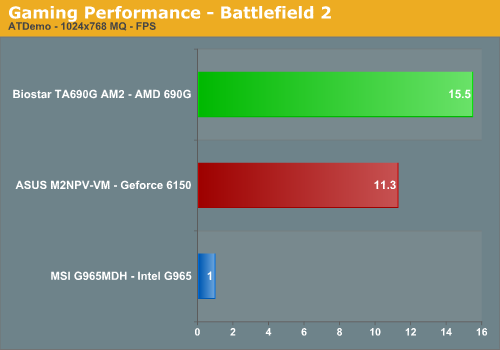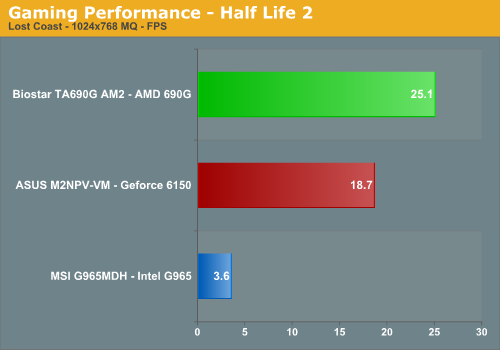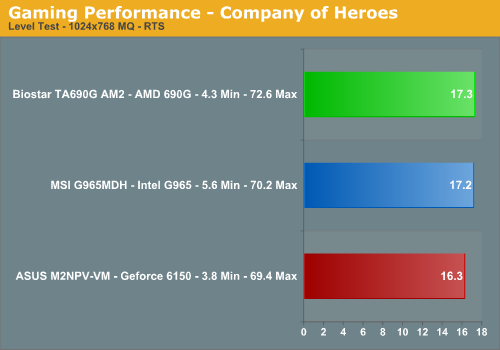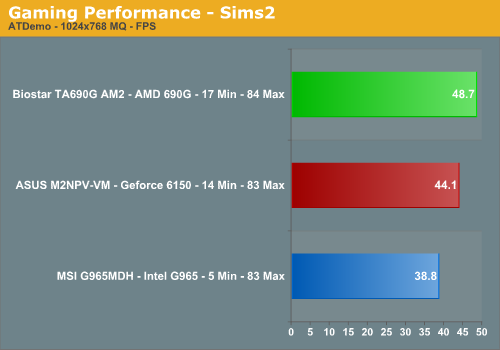Gaming Performance
As usual, gaming performance was tested with a variety of current games. We ran benchmarks at a 1024x768 resolution. Any more than this resulted in completely unplayable game conditions, although we did find several older non-FPS games such as the Civilization series, Railroad Tycoon 3, Rollercoaster Tycoon series, and others played acceptability at 1280x1024 with the quality settings at normal. We concentrated on Direct X games as OpenGL support under Vista is bad at this time.
Battlefield 2
This benchmark is performed using DICE's built-in demo playback functionality with additional capture capabilities designed in house. During the benchmark, the camera switches between players and vehicles in order to capture the most action possible. There is a significant amount of smoke, explosions, and vehicle usage as this a very GPU intensive Battlefield 2 benchmark. We run Battlefield 2 using medium quality graphics settings available in the video settings. The game itself is best experienced with average in-game frame rates of 35 and up.

Half-Life 2: Lost Coast
We use the built-in timedemo feature to benchmark the game. Our timedemo consists of starting at the bottom of the hill near the lake and ending in the old church. The Source engine timedemo feature is similar to the nettimedemo of Id's Doom 3 engine, in that it plays back more than just the graphics. The visual quality settings were set to high or medium where possible with HDR off. While the Source engine is notorious for giving great frame rates for almost any hardware setup, we find the game isn't as enjoyable if it isn't running at 35fps or above.

Company of Heroes
Company of Heroes was recently released and is proving to be a very addictive RTS game around the office. This game is very GPU intensive and also requires a hefty CPU at times. The game contains a built-in performance test that utilizes the game engine to generate several different action scenes along with a coffee argument as a sideline distraction before the war starts. We found the performance test gives a good indication of how well your system will perform throughout the game on average. Some of the in-game action sequences are more demanding than the performance test, but we generally found the game to be enjoyable with an average performance test frame rate above 30fps.

Sims 2
Sims 2 was released over two years ago and is constantly being updated with best selling expansion packs. In testing with the various expansion packs we did not notice any measurable differences in performance so our benchmark will be reflective of game play using the base game title. This particular game requires a decent CPU and very good GPU when utilizing the antialiasing, shadow, or high quality texture options.
We utilize FRAPS to capture the results from our replay file. Our benchmark consists of a three character scenario that takes approximately twenty minutes to set up and cycle through a series of daily events. The camera movements are varied as is the movement so we feel like this benchmark represents the typical game. We set most video options to high but disable shadows. We generally found the game to be enjoyable with an average frame rate above 30fps.

Gaming Summary
What else can you really say after reviewing the results? They are generally pathetic from a gaming perspective but the 690G obviously has some potential left in it at the lower resolutions. The 6150 performs okay considering the age of its core and we will see the new 6150SE and older 6100 chipset performing a few percent better overall but not enough to catch the 690G.
Considering the G965 was launched last fall and promised to bring about a difference in on-board video performance, we are still not seeing the results live up to the hype. The G965 was incapable of running Battlefield 2 at all and Half-Life 2 was an interesting slide show that allowed you to see every detail of the benchmark session in an excruciatingly slow way that would make a visit to the dentist for a root canal seem pleasant. However, G965 was able to generate decent results (for this grouping) in Company of Heroes and Sims 2, though the minimum frame rates in Sims 2 would bring the game to a slow crawl at times. Image quality generally favored the 690G in the majority of games we tried but the NVIDIA 6150 was close in most titles. The G965 had acceptable image quality but we could tell certain details were not as sharp or even evident when compared to the competing AM2 solutions.
As usual, gaming performance was tested with a variety of current games. We ran benchmarks at a 1024x768 resolution. Any more than this resulted in completely unplayable game conditions, although we did find several older non-FPS games such as the Civilization series, Railroad Tycoon 3, Rollercoaster Tycoon series, and others played acceptability at 1280x1024 with the quality settings at normal. We concentrated on Direct X games as OpenGL support under Vista is bad at this time.
Battlefield 2
This benchmark is performed using DICE's built-in demo playback functionality with additional capture capabilities designed in house. During the benchmark, the camera switches between players and vehicles in order to capture the most action possible. There is a significant amount of smoke, explosions, and vehicle usage as this a very GPU intensive Battlefield 2 benchmark. We run Battlefield 2 using medium quality graphics settings available in the video settings. The game itself is best experienced with average in-game frame rates of 35 and up.

Half-Life 2: Lost Coast
We use the built-in timedemo feature to benchmark the game. Our timedemo consists of starting at the bottom of the hill near the lake and ending in the old church. The Source engine timedemo feature is similar to the nettimedemo of Id's Doom 3 engine, in that it plays back more than just the graphics. The visual quality settings were set to high or medium where possible with HDR off. While the Source engine is notorious for giving great frame rates for almost any hardware setup, we find the game isn't as enjoyable if it isn't running at 35fps or above.

Company of Heroes
Company of Heroes was recently released and is proving to be a very addictive RTS game around the office. This game is very GPU intensive and also requires a hefty CPU at times. The game contains a built-in performance test that utilizes the game engine to generate several different action scenes along with a coffee argument as a sideline distraction before the war starts. We found the performance test gives a good indication of how well your system will perform throughout the game on average. Some of the in-game action sequences are more demanding than the performance test, but we generally found the game to be enjoyable with an average performance test frame rate above 30fps.

Sims 2
Sims 2 was released over two years ago and is constantly being updated with best selling expansion packs. In testing with the various expansion packs we did not notice any measurable differences in performance so our benchmark will be reflective of game play using the base game title. This particular game requires a decent CPU and very good GPU when utilizing the antialiasing, shadow, or high quality texture options.
We utilize FRAPS to capture the results from our replay file. Our benchmark consists of a three character scenario that takes approximately twenty minutes to set up and cycle through a series of daily events. The camera movements are varied as is the movement so we feel like this benchmark represents the typical game. We set most video options to high but disable shadows. We generally found the game to be enjoyable with an average frame rate above 30fps.

Gaming Summary
What else can you really say after reviewing the results? They are generally pathetic from a gaming perspective but the 690G obviously has some potential left in it at the lower resolutions. The 6150 performs okay considering the age of its core and we will see the new 6150SE and older 6100 chipset performing a few percent better overall but not enough to catch the 690G.
Considering the G965 was launched last fall and promised to bring about a difference in on-board video performance, we are still not seeing the results live up to the hype. The G965 was incapable of running Battlefield 2 at all and Half-Life 2 was an interesting slide show that allowed you to see every detail of the benchmark session in an excruciatingly slow way that would make a visit to the dentist for a root canal seem pleasant. However, G965 was able to generate decent results (for this grouping) in Company of Heroes and Sims 2, though the minimum frame rates in Sims 2 would bring the game to a slow crawl at times. Image quality generally favored the 690G in the majority of games we tried but the NVIDIA 6150 was close in most titles. The G965 had acceptable image quality but we could tell certain details were not as sharp or even evident when compared to the competing AM2 solutions.










70 Comments
View All Comments
chucky2 - Wednesday, March 7, 2007 - link
BlingBlingArsch of the AnandTech forums linked to some pictures of the board, and there's one of the back panel I/O: http://img256.imageshack.us/img256/5498/board234cx...">http://img256.imageshack.us/img256/5498/board234cx...Looks like there's definitely no Firewire... :( :( :(
What are these manufacturers thinking (or rather not thinking) not including Firewire on this boards? These would be totally complete solutions, especially this Abit with the optical out it has, if they'd only have Firewire on them...
...and the expansion is so limited, putting in an add-in Firewire basically kills for TV tuner, capture, etc. additions.
Man...talk about something that's almost perfect that gets ruined by either a poor design decision or a poor bean counter decision... :(
Chuck
Myrandex - Wednesday, March 7, 2007 - link
"The 6150 performs okay considering the age of its core and we will see the new 6150SE and older 6100 chipset performing a few percent better overall but not enough to catch the 690G."How would the 6100 be a few percent better when it is clocked lower?
Renoir - Tuesday, March 6, 2007 - link
The review over at http://www.bit-tech.net/hardware/2007/03/02/amd_69...">Bit-tech.netsays the 690G supports dual-link DVI and confirmed as much by sending 2560x1600 over DVI to the dell 30incher. This review however says "Larger 30" flat panel monitors won't be able to run at native resolution" and the technology overview article says "The digital outputs use TMDS transmitters that run at 165MHz". What's the deal?Gary Key - Wednesday, March 7, 2007 - link
The 690G supports Dual-Link DVI. We had stated this on page two but not in a separate section. I will reword the 2D paragraph to make this clear. As for the resolution, I am using a Samsung 30" panel and the current Vista drivers limit me to 2048x1536. I have sent a board to Jarred who has the Dell 30" to test on it. AMD still confirms that 2048x1536 is the "current" max resolution although we know the hardware has 2560x1600 capability according to one of our sources.Renoir - Wednesday, March 7, 2007 - link
Hmmm something's not quite right it seems. Can't see why they were able to send 2560x1600 if you couldn't. Would definitely appreciate Jarred checking it on the dell although I'd be surprised if it was a monitor issue. Who knows without trying. Have asked bit-tech what os they were using to get it to work. An XP vs Vista issue perhaps? The related paragraph in the technology overview article mentions the TMDS's run at 165mhz which I understand is single-link? Have seen the 165mhz listed elsewhere for the 690G so am curious where this info comes from if the chipset is dual-link? Unless I've misunderstood something about "165mhz"?Gary Key - Wednesday, March 7, 2007 - link
The DVI spec transmits data using the transition minimized differential signaling (TMDS) protocol. The DVI spec calls for each DVI output to have at least one TMDS “link” consisting of three data channels (RGB) and one control channel. The maximum speed at which a single 10-bit TMDS link may operate at is 165MHz, offering 1.65Gbps of bandwidth. In real world terms, this means a single 10-bit TMDS link can drive a display at up to 1920 x 1200 (the actual maximum resolution can vary depending on the panel, spec is 1920x1080). For most displays that’s not a problem, but the 30” Displays have a native resolution of 2560 x 1600, which exceeds the bandwidth a single TMDS link can deliver. So what do you do? Remember that the DVI spec calls for at least one TMDS link, but each DVI port can support up to two TMDS links (the 690G has dual TDMS links), thus doubling the maximum bandwidth and enabling support for a 30" (if driver support is present) display or even some of the new 27" units that can run at 2048x1560.Renoir - Thursday, March 8, 2007 - link
Thanks for the reply Gary. That was precisely my understanding of the situation which is why I found the following quote from the technology overview article confusing "The digital outputs each use TMDS transmitters that run at 165MHz." This sentence didn't come across as saying the digital outputs had 2 TMDS "links" but rather just 1 running at 165mhz (hence single-link). Perhaps you could reword it to explain that each link runs at 165mhz but that there are actually 2 links in order to support the higher resolutions afforded by dual-link DVI. Don't mean to be picky just think this part could be a little clearer :-)As for the resolution cap at 2048x1536 you guys are experiencing the Bit-Tech guys have confirmed they got 2560x1600 working on XP and suggest your problem is an issue with the current vista drivers.
Gary Key - Thursday, March 8, 2007 - link
I have a new Vista driver as of today.Here are the specs -
DVI - Supports dual link up to 2560x1600.
HDMI - maximum resolution supported is 1920x1080 (using a HDMI-DVI cable
you can go up to 1920x1200)
VGA- Maximum resolution support depends on monitor refresh rates and aspect
ratios:
2048x1536 @ 85 Hz in 4:3 format
2560x1440 @ 75 Hz in 16:9 format
2728x1536 @ 60 Hz in 16:9 format
2456x1536 @ 60 Hz in 16:10 format
Hope that helps.
Renoir - Thursday, March 8, 2007 - link
That's cleared that up then (was merely a driver issue). Anyhow 2 questions1) Both digital outputs support HDCP but are on separate display controllers. Does that mean they have 2 built in cryptoroms (1 for each controller) given that separate cryptoroms are required for each controller/output? If they do have 2 then why only allow HDCP on one output at a time?
2) In a related point (upcoming mobile version of chipset) what connection do laptops use internally for their screens? The reason I ask is I'm interested in getting a laptop in future which supports both hdcp for the laptop screen but also via an external digital connection to a larger display.
jonman03 - Tuesday, March 6, 2007 - link
I know its onboard video and stuff, but a 3D Mark06 score of 313? They should be able to better than that, see who can get it into the 1000's first. Although unlikely, it'd be a nice alternative to buying a video card for a basic computing system.http://www.plugcomputers.com">Custom Gaming Computers